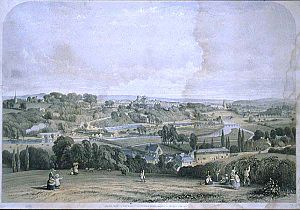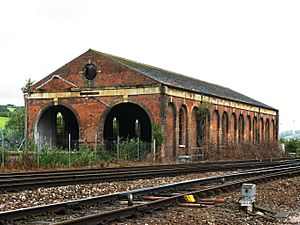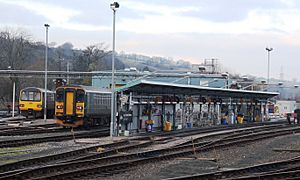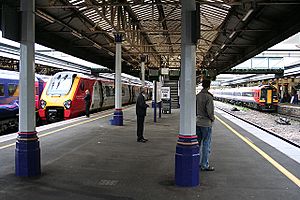Exeter St David's railway station facts for kids
Quick facts for kids
|
|
|---|---|
 |
|
| Location | Exeter, Exeter England |
| Coordinates | 50°43′47″N 3°32′37″W / 50.7296°N 3.5435°W |
| Platforms | 6 |
| Other information | |
| Station code | EXD |
| Classification | DfT category C1 |
| History | |
| Original company | Bristol and Exeter Railway |
| Pre-grouping | Great Western Railway |
| Post-grouping | Great Western Railway |
| Key dates | |
| 1844 | Opened |
| 1864 | Rebuilt for LSWR |
| 1913 | Rebuilt without roof |
| Traffic | |
| Passengers (2015/16) | |
| Passengers (2016/17) | |
| Passengers (2017/18) | |
| Passengers (2018/19) | |
| Passengers (2019/20) | |
Exeter St Davids is the principal railway station serving the city of Exeter in Devon, England. It is 193 miles 72 chains (312.1 km) from London Paddington on the line through Bristol which continues to Plymouth and Penzance. It is also served by an alternative route to London Waterloo via Salisbury and branch lines to Exmouth and Barnstaple.
The station opened in 1844 as the terminus of the Bristol and Exeter Railway. It is currently managed by Great Western Railway and is served by trains operated by Great Western Railway, South Western Railway and CrossCountry.
Contents
History
The station was opened on 1 May 1844 by the Bristol and Exeter Railway (B&ER). The station was designed by Isambard Kingdom Brunel and was one of his single-sided stations which meant that the two platforms were both on the east side of the line. This was the side nearer the town and so very convenient for passengers travelling into Exeter but did mean that a lot of trains had to cross in front of others.
This was not too much of a problem while the station was at the end of the line, but on 30 May 1846 the South Devon Railway (SDR) opened a line westwards towards Plymouth. A carriage shed was built for the SDR at the south end of the B&ER platform but the goods sheds and locomotive sheds for both companies were to the west, between the station and the River Exe. The SDR was designed to be worked by atmospheric power and an engine house was built on the banks of the river near the locomotive shed. This was only used for its original purpose for about a year but was not demolished until many years later.
The next railway to arrive at St David's was the Exeter and Crediton Railway on 12 May 1851, the junction of which was a little distance to the north of the station at Cowley Bridge Junction. This line was worked by the B&ER and trains were accommodated at the existing platforms. All these railways had been built to the 7 ft (2,134 mm) broad gauge, but on 1 February 1862, the 4 ft 8 1⁄2 in (1,435 mm) gauge London and South Western Railway (LSWR) brought a line into the station from their own central station in Queen Street. The LSWR owned the Exeter and Crediton Railway and started to work the line for itself, although the broad gauge was retained for the B&ER to work goods trains to Crediton.
With two gauges and four companies using the single-sided station, it was in need of remodelling. A new double-sided platform opened on the site west side of the line and the original up platform at the northern end was closed. The original platforms had all had individual train sheds covering the tracks, and the opportunity was taken to replace these with one large train shed across all the main tracks and platforms. North of the station was a level crossing and just beyond this an additional goods shed was constructed. Unlike the earlier ones it was solely for transferring goods between the trains of the two different gauges. All of these buildings were designed by Francis Fox, the B&ER engineer, and Henry Lloyd and the work was completed in 1864.
The B&ER was amalgamated with the Great Western Railway on 1 January 1876 and the SDR did the same thing exactly one month later. The mainline from Bristol was rebuilt with mixed gauge track that allowed broad gauge trains to run through from London Paddington railway station to Penzance, while at the same time offering a standard gauge track for local trains from Bristol Temple Meads; the new line being ready by 1 March 1876.
The train shed was removed in 1912-13 and the platforms extended northwards towards the level crossing. A second island platform was provided on the west side and this entailed the goods shed being narrowed from two tracks to one at their southern end. The middle island platform was mainly used for LSWR trains while down GWR services used the original main platform and the new island platforms. Before Southern Region services to Plymouth were abandoned, passengers could see Plymouth-bound services of the Western Region and Southern Region leaving St Davids in opposite directions. The station has remained largely in this form since, but resignalling in the 1985 saw the ex-LSWR services moved to the main platform so that down ex-GWR line services did not have to cross their path at the south end of the station. A through-line between platforms 1 and 3 was removed at the same time. The new signal box was built on the site of the old atmospheric engine house and replaced three older signal boxes.
There are still many remains of the earlier stations to be seen. The main façade dates from 1864 and the Great Western Hotel dates from the earliest days, as does the southern section of platform 1. The goods shed opposite platform 6 shows the angle where the southern end was cut back in 1912, and at the northern end, part of the original goods shed still stands beneath later extensions. The 1864 transfer shed can still be seen beside the line beyond Red Cow Crossing.
Station Masters
- William Mears ca. 1850 - 1891
- Samuel Morris 1891 - 1900
- H.E. Williams 1900 - 1911 (formerly station master at Newton Abbot)
- John Lea 1911 - 1922 (formerly station master at Slough, afterwards station master at Reading)
- W.E. Denton 1922 - 1926
- A.J. Humphrey 1926 - 1928 (formerly station master of Weymouth)
- Ernest Tom Evans 1928 - 1938 (formerly station master at Gloucester)
- W.J. Gush 1938 - 1939
- William Nicholls 1939 - 1945 (formerly station master at Wolverhampton Low Level)
- F.G. Elmore ca. 1950
Description
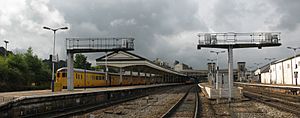
The station entrance is on the east side of the line, facing the city centre which is about a 15 minutes walk. The routes to the centre and Exeter University are well signposted. There are also frequent bus services to the centre from outside the station and trains to Exmouth and London Waterloo call at Exeter Central railway station.
The main buffet and bookshop are both outside the ticket gates. There are also a number of local shops outside the station along with the Great Western Hotel and a Premier Inn hotel. There is a smaller buffet on platforms 5 & 6.
The entrance is on platform 1, which is mainly used for trains to and from Exeter Central and Barnstaple. It is signalled so that two trains can be on the platform simultaneously, with the south end marked as platform 1A. At the north end is platform 2, a separate bay platform that is used from time to time for trains to and from the north – mainly Bristol and Barnstaple – that start or terminate at St Davids.
The main passenger footbridge has many paintings resembling frescoes and depicting romantic versions of rail travel. A second bridge fitted with lifts provides disabled access. When the lifts are out of action a member of station staff escorts people across a foot crossing at track level towards the south of the station.
The middle pair of platforms is numbered 3 & 4. The former is used by similar trains to platform 1, but platforms 4-6 do not have access to the lines from Exeter Central. Instead platform 4 is the main platform for inter-city trains to Paignton, Plymouth and Penzance. Trains from both platforms 1 and 3 can also reach this route so trains from Exmouth that continue westwards will reverse in one of these platforms.
The third platform block sees northbound trains to London Paddington and the North use platform 5. Various local services use platform 6 as do trains from Paddington or the North that terminate at Exeter then return northwards.
Beyond platform six is the Exeter panel signal box that controls not just St Davids but also the main line north through to Taunton & Cogload Junction and southwards to Totnes & Torquay as well the branches out to Exmouth Junction and Crediton. Next to this is Exeter Traincare Depot where DMU sets used on local services are fuelled. A goods shed is situated beyond Red Cow Crossing at the north end of the platforms, and finally beyond that is Riverside Yard which still sees goods traffic. Cowley Bridge Junction is about a mile away at the far end of Riverside Yard, but the junction for the Exeter Central line is right by the south end of the platforms. This line curves eastwards and climbs steeply to cross a small viaduct before entering a tunnel beneath the city; the main line instead stays on the level and crosses both the River Exe and the city's flood defence channel before curving gently out of sight.
Passenger volume
Exeter St Davids is the busiest station in Devon, handling around 2,619,776 passengers a year in 2018/19. This is just ahead of nearby Exeter Central station (2,532,450) and 200,000 more than Plymouth, where 2,416,376 journeys began or ended.
Comparing the year from April 2007 to that which started in April 2002, passenger numbers increased by 30%.
| 2002-03 | 2004-05 | 2005-06 | 2006-07 | 2007-08 | 2008-09 | 2009-10 | 2010-11 | 2011-12 | |
|---|---|---|---|---|---|---|---|---|---|
| Entries | 766,438 | 817,325 | 851,156 | 902,106 | 993,505 | 1,064,292 | 1,076,393 | 1,133,025 | 1,197,061 |
| Exits | 763,280 | 814,960 | 846,271 | 898,727 | 988,931 | 1,064,292 | 1,076,393 | 1,133,025 | 1,197,061 |
| Interchanges | unknown | 402,464 | 417,684 | 445,833 | 455,666 | 680,797 | 593,759 | 638,146 | 784,929 |
| Total | 1,529,718 | 2,034,749 | 2,115,112 | 2,246,666 | 2,438,102 | 2,809,381 | 2,746,545 | 2,904,196 | 3,179,051 |
The statistics cover twelve month periods that start in April.
Services
There are two direct routes from St Davids to London. The main line is generally considered to be the Great Western Railway service via the Reading–Taunton line to London Paddington but there is also a service operated by South Western Railway on their West of England Main Line to London Waterloo via Salisbury and Basingstoke. Because of this the station is one of the few that have trains to London departing in opposite directions at either end of the station – those to Paddington leave northwards while those to Waterloo head south but turn eastwards, and start the steep climb to Exeter Central just outside the station. Further long-distance services are operated by CrossCountry to Birmingham New Street, Manchester Piccadilly, Sheffield, Leeds, York, Newcastle, Edinburgh, Glasgow and Aberdeen.
Three local routes converge at St David's – the Avocet Line from Exmouth, the Tarka Line from Barnstaple, and the Riviera Line from Paignton. Trains from Exmouth generally continue to either Barnstaple or Paignton to provide a cross-Exeter service. A few GWR services also run between Paignton/Plymouth and Bristol or Cardiff Central, mainly in the morning & late evening.
In addition to this core daytime pattern there are a number of other, less frequent, services including the Night Riviera sleeping car service from London Paddington to Penzance. On summer Sundays services are operated over the Tarka Line and then on an otherwise goods-only line to Okehampton on the Dartmoor Railway, and the steam-hauled "Torbay Express" calls on its weekly run to Paignton and Kingswear on the Paignton and Dartmouth Steam Railway.
| Preceding station | Following station | |||
|---|---|---|---|---|
| Tiverton Parkway | CrossCountry Scotland and North to South West |
Dawlish | ||
| Tiverton Parkway | Great Western Railway Bristol to Exeter line |
Exeter St Thomas | ||
| Exeter Central | Great Western Railway Exmouth to Paignton |
Exeter St Thomas | ||
| Great Western Railway Exmouth to Barnstaple |
Newton St Cyres | |||
| Taunton | Great Western Railway Night Riviera |
Newton Abbot | ||
| Exeter Central | South Western Railway London Waterloo to Exeter St Davids |
Terminus | ||
| Future development | ||||
| Exeter Central | Great Western Railway Exeter to Okehampton |
Crediton | ||
Bus services
There are several bus services from the station operated by Stagecoach South West including route H to the High Street and Royal Devon & Exeter Hospital. The 56 service goes to the Met Office or Exeter Airport other services include the 5A, 5B, 6,6A and the 55A.
Images for kids
See also
 In Spanish: Estación de Exeter St Davids para niños
In Spanish: Estación de Exeter St Davids para niños


